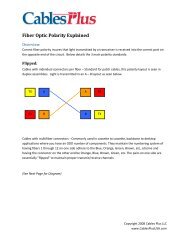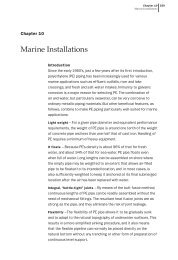Learning About Options in Fiber - Cables Plus USA
Learning About Options in Fiber - Cables Plus USA
Learning About Options in Fiber - Cables Plus USA
Create successful ePaper yourself
Turn your PDF publications into a flip-book with our unique Google optimized e-Paper software.
Four different conditions exist:<br />
SECTION 2—FIBER-OPTIC BASICS<br />
Specifically, the fusion splice consists of:<br />
• Short launch, short receive.<br />
• Short launch, long receive.<br />
• Long launch, short receive.<br />
• Long launch, long receive.<br />
LOSS IN SINGLE-MODE FIBERS<br />
It is important to note that connectors and splices for<br />
s<strong>in</strong>gle-mode fibers must also provide a high degree<br />
of alignment. In many cases, the percentage of misalignment<br />
permitted for a s<strong>in</strong>gle-mode connection is<br />
greater than for its multimode counterpart. Because<br />
of the small size of the fiber core, however, the<br />
actual dimensional tolerances for the connector or<br />
splice rema<strong>in</strong> as tight or tighter.<br />
ALIGNMENT MECHANISMS AND<br />
SPLICE EXAMPLES<br />
Many different mechanisms have been used to<br />
achieve the high degree of alignment that is<br />
required <strong>in</strong> a connector or splice. Splic<strong>in</strong>g is the<br />
name of the process whereby two fibers or cables<br />
are jo<strong>in</strong>ed together. <strong>Fiber</strong> splic<strong>in</strong>g consists of:<br />
preparation of the fiber; cleav<strong>in</strong>g the fiber; <strong>in</strong>spection<br />
of the cleave; plac<strong>in</strong>g of the fibers <strong>in</strong> an alignment<br />
fixture; alignment or tun<strong>in</strong>g of fibers; bond<br />
splice; <strong>in</strong>spection and test<strong>in</strong>g; and enclos<strong>in</strong>g of<br />
the splice for protection.<br />
Basically, there are two types of splices: fusion<br />
and mechanical.<br />
FUSION SPLICES<br />
The fusion splice is accomplished by apply<strong>in</strong>g<br />
localized heat<strong>in</strong>g at the <strong>in</strong>terface between two<br />
butted, prealigned fiber ends, caus<strong>in</strong>g the fibers<br />
to soften and fuse together to form a cont<strong>in</strong>uous<br />
glass strand. This system offers the lowest light<br />
loss and the highest reliability. Loss should be at<br />
.5 dB/splice or less.<br />
• Jo<strong>in</strong><strong>in</strong>g glass fibers by melt<strong>in</strong>g them together<br />
us<strong>in</strong>g an electric arc.<br />
• Precision controlled for fiber uniformity.<br />
• Permanent, highly reliable, low <strong>in</strong> cost.<br />
• Average of 50 splices can be done per day <strong>in</strong><br />
one location by a s<strong>in</strong>gle team of two persons.<br />
• Typically 0.1 to 0.3 dB loss per splice.<br />
A fusion-splice jo<strong>in</strong>t can ma<strong>in</strong>ta<strong>in</strong> a break<strong>in</strong>g stra<strong>in</strong><br />
of more than one percent. This means that such<br />
splices can be used when manufactur<strong>in</strong>g fiberoptic<br />
cable if long, cont<strong>in</strong>uous cables of tens of<br />
kilometers are required.<br />
The down side of this method is that tra<strong>in</strong><strong>in</strong>g is<br />
required before us<strong>in</strong>g the expensive equipment<br />
that effects the fusion splice. Depend<strong>in</strong>g on the<br />
complexity of the <strong>in</strong>stallation, this may not be the<br />
first choice.<br />
The fusion-splice process employed can vary<br />
depend<strong>in</strong>g on the type of splicer used. The two<br />
most common types are the local <strong>in</strong>jection detection<br />
(LID) splicer and the manual splicer. Both splicers<br />
use electrodes to melt the fiber ends together.<br />
The LID Splicer<br />
The LID splicer or automatic splicer, is a process<br />
that employs microbend<strong>in</strong>g techniques to launch<br />
light <strong>in</strong>to the fiber before the fiber end. On the<br />
opposite fiber to be spliced a microbend is aga<strong>in</strong><br />
used, but this time with a detector to remove the<br />
launched light. This allows the processor <strong>in</strong> the<br />
splicer to align the fiber to where the greatest<br />
optical power level is achieved.<br />
The process for this splic<strong>in</strong>g is position<strong>in</strong>g the fiber<br />
<strong>in</strong> clamps and alignment fixtures. By activat<strong>in</strong>g the<br />
automatic alignment function, the splicer runs<br />
though various X, Y, and Z alignments for optimiz<strong>in</strong>g<br />
the transmission through the two fiber ends.<br />
When this is accomplished, the splicer <strong>in</strong>dicates<br />
maximum alignments and the splicer operator then<br />
fuses the fibers by activat<strong>in</strong>g electrodes.<br />
2-19
















